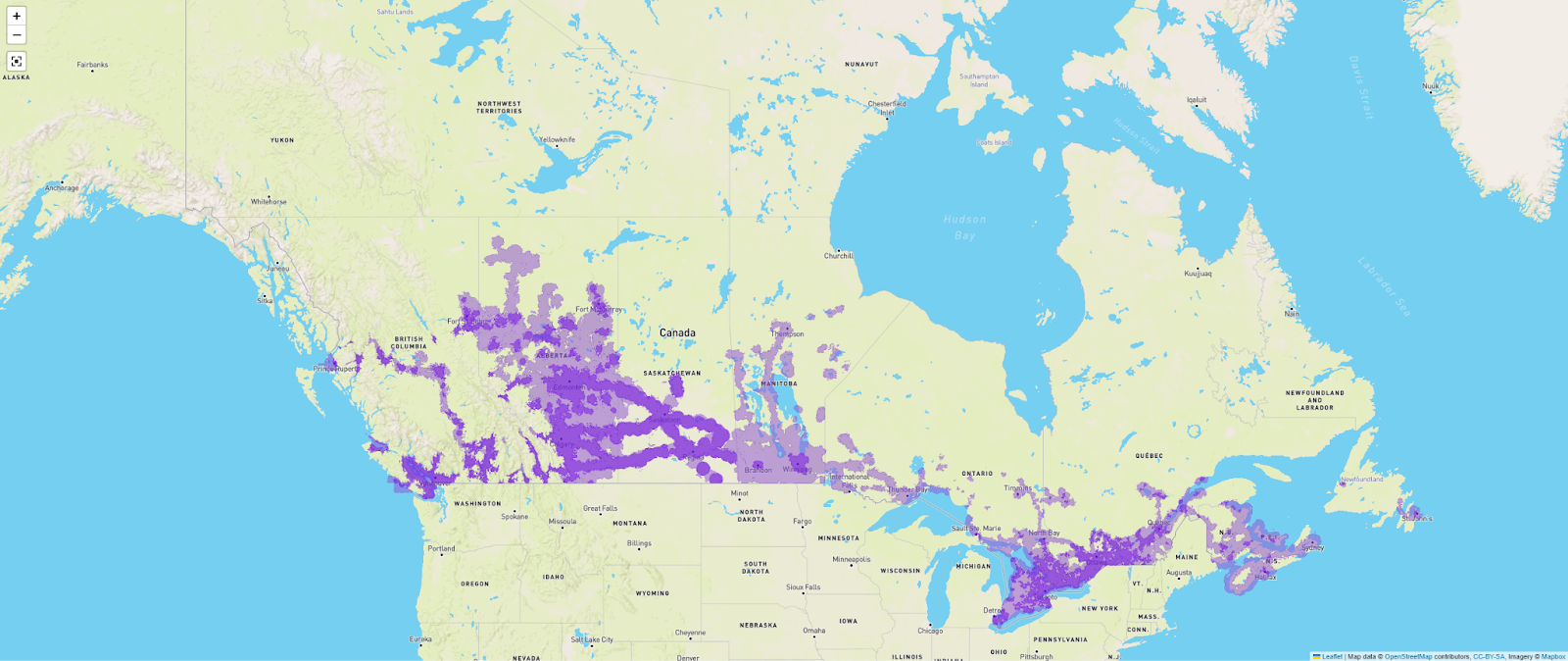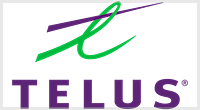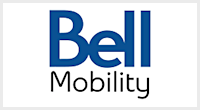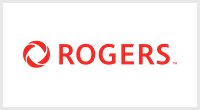Rogers is one of the country’s largest wireless carriers, with 4G LTE coverage reaching over 97% of Canadians. The carrier’s expanding 5G network is also one of Canada's largest, reaching 70% of residents (though it mostly centers on densely populated urban centres. You can also find the Rogers network available through several MVNOs (including Fido and Chatr), which offer access to Rogers’ reliable nationwide network at discounted prices.

Recently, I went hands-on with the carrier's services to conduct a thorough review. As part of it, I walked away quite pleased with Rogers' 5G network in the Toronto area, where I found faster speeds and reliable coverage.
In this guide, we’ll break down everything you need to know about the Rogers network, including its 5G coverage map, and analyze how it stacks up against Telus, Bell, and Freedom Mobile. We’ll also recommend some more affordable Rogers MVNOs if you’re looking to save on your monthly bill.
Rogers coverage: Pros and cons
What we love
- Large (and growing) 5G coverage
- 97% 4G LTE coverage
- Low-cost coverage through MVNOs and flankers
What could be improved
- 5G is limited to urban areas
-
The Rogers 5G network covers 70% of Canadians across major metro areas in the country. The overwhelming majority of Canadians live near the country’s urban centres, so the Big Three have largely ignored the sparsely populated stretches of Canada’s northern wilderness as they expand their 5G coverage.
You can find pockets of the Yukon and Northwest Territories with access to Rogers’ Extended Coverage if you’re travelling, though the carrier emphasizes that Extended Coverage is only for “limited and occasional use.” While under the Extended Coverage, Rogers provides LTE speeds in select areas. You'll know you're connected when you see "EXT" on the top corner of your device. Want to see if the Rogers network covers your neck of the woods? Use the interactive map below to zoom in on your neighbourhood and see if Rogers' service is available near you.
90/100
Rogers coverage map

The Rogers 5G network covers 70% of Canadians across major metro areas in the country. The overwhelming majority of Canadians live near the country’s urban centres, so the Big Three have largely ignored the sparsely populated stretches of Canada’s northern wilderness as they expand their 5G coverage.
You can find pockets of the Yukon and Northwest Territories with access to Rogers’ Extended Coverage if you’re travelling, though the carrier emphasizes that Extended Coverage is only for “limited and occasional use.” While under the Extended Coverage, Rogers provides LTE speeds in select areas. You'll know you're connected when you see "EXT" on the top corner of your device.
Want to see if the Rogers network covers your neck of the woods? Use the interactive map below to zoom in on your neighbourhood and see if Rogers' service is available near you.
How good is Rogers' 5G coverage near you?

If you live in a more rural area, you likely won’t see strong 5G signals, especially compared to customers in major cities. But the carrier is expanding its 5G+ network technology in five provinces.
British Columbia, Alberta, Manitoba, Ontario, and Quebec are the focal hubs of Rogers' 5G network expansion, which they say will deliver faster speeds and more consistent coverage. In the Toronto area, especially, I've found that 5G connectivity is well within reach, with coverage expanding towards Niagara Falls and out to the Ottawa area.
Rogers offers several 5G cell phone plans, including the Essential Plan, which provides 100GB of full-speed 5G data and the Ultimate plan, which gives you 250GB of full-speed 5G data.Want Rogers coverage without Rogers prices?
MVNOs offer access to the Rogers network at a fraction of the cost. Carriers like Fido, Chatr, SimplyConnect, and Cityfone provide deals and discounts, with plans starting as low as $15/month.
How fast is Rogers' 5G network?
Rogers' network speeds ultimately depend on several factors. The company's 5G service can provide download speeds of up to 1Gbps on its Popular and Ultimate plans. However, if you sign up for the carrier's Essentials plan, you'll be granted access to speeds of up to 250Mbps, which is still plenty of speed.
This being said, other factors contribute to your peak download speeds. For instance, densely populated areas can affect the overall speeds. In areas where the network is congested, you may experience slower download speeds. However, in areas where Rogers' 5G and 5G+ network is the strongest, like the GTA, I've found that speeds can be easily sustained around 250Mbps or above.
Rogers 4G LTE coverage map
Is Rogers 4G LTE coverage available in your neighbourhood?
Outside of the main metro hubs across Canada, Rogers supports a strong 4G LTE network in the country. From the East Coast over to the West, Rogers operates one of the largest 4G networks. Rural customers can access 4G LTE connectivity if outside of a populated city in Northern and Western Ontario, where I travelled to test the carrier's services this summer.
Here's a look at Bell's LTE coverage map. As you can see, much of the LTE coverage spans Southern Ontario, Quebec, as well as Manitoba and Alberta. More populated regions across BC and Nova Scotia also have wide-ranging access to LTE services.
How fast is Rogers' 4G LTE network?
Comparatively, speeds on Rogers' 4G LTE will be slower than those found on the 5G network. This is typical as the 5G infrastructure is built to offer improved speeds and reliability. That said, Rogers provides stable download speeds of around 75Mbps. In many cases, carriers can offer around 200Mbps on an LTE signal. However, during my tests this year, I experienced upwards of 120Mbps speeds on Rogers' 4G service.
Rogers network vs. Telus, Bell, and Freedom Mobile
Now that you’ve got a good sense of the Rogers coverage map, let’s see how it stacks up against Canada’s three other major wireless networks: Telus, Bell, and Freedom Mobile.
Network coverage in Canada
| Carrier | 5G coverage | 4G LTE coverage | Total network coverage |
|---|---|---|---|
| Telus | 70% | 99% | 99% |
| Bell | 70% | 99% | 97% |
| Rogers | 70% | 97% | 99% |
| Freedom | 31% | 99% | 99% |
Telus vs. Rogers coverage map

Telus has the largest network in Canada, with its 4G LTE reaching over 99% of residents. Telus and Bell share cell towers, which allows both carriers to have larger footprints than Rogers. Telus’ network covers 37% of the country’s land mass, including rural stretches of Canada in the Yukon, Northwest Territories, and Nunavut, where Rogers is largely unavailable.
Telus’ 5G service mostly matches Rogers’, with coverage primarily limited to metropolitan areas. Like Rogers, their 5G service reaches 70% of the population. Also like Rogers, the carrier plans on expanding the reach of its 5G network in the coming years.
Want to see if Telus coverage is available near you? Use the interactive map below.
Bell vs. Rogers coverage map

Coverage maps for Bell and Telus look remarkably similar, and with good reason: the carriers share some cell towers, allowing them to help each other build the largest wireless networks in Canada. Bell’s footprint is slightly smaller than Telus’, covering 36% of the map, though it’s significantly larger than Rogers’ 28% slice.
Bell’s 5G coverage also reaches 70% of Canadians. Similar to Rogers, they advertise 5G+ service in urban hubs, promising faster speeds in typically congested areas like stadiums and concert venues.
Want to get a more granular view of the Bell coverage map? Zoom in on our interactive map below to see where the carrier offers 5G and 4G LTE service.
Freedom Mobile vs. Rogers coverage map

Many Canadians see Freedom Mobile as the best challenger to the oligopoly of the Big Three. Still, Freedom’s network is comparable to Rogers, Telus, and Bell. If you’re in a more rural area, there’s a good chance Freedom’s 5G service isn’t available.
That doesn’t mean it’s not available to Canadians: The carrier’s 4G LTE service reaches 99% of Canadians, despite its modest coverage area. That's comparable to Bell and Telus and exceeds Rogers' 97%. Most of Freedom’s coverage is limited to dense urban areas.
In July 2023, Freedom announced 5G coverage, with service that reaches 31% of Canadians. Freedom’s 5G network may sound new, but it’s actually thanks to pre-existing towers the carrier now shares with Videotron, its partner brand.
If you’d like to see if Freedom Mobile’s 5G or 4G LTE service is available near you, take a look at the coverage map below.
Rogers Wireless network reliability
Umlaut, a telecom research company, named Rogers the most reliable wireless network in Canada out of the Big Three. The total possible score was 600: Rogers earned 547, Bell earned 526, and Telus rounded things out with 510. Rogers was also recognized for its low latency and call quality within cities and towns in Canada.
If you’re looking to see how reliable Rogers' network coverage is near you, you can find that in one of our geographic guides below.
Cell phone coverage guides by province:
- British Columbia Wireless Coverage
- Alberta Wireless Coverage
- Saskatchewan Wireless Coverage
- Manitoba Wireless Coverage
- Ontario Wireless Coverage
- Quebec Wireless Coverage
- New Brunswick Wireless Coverage
- Nova Scotia Wireless Coverage
- Prince Edward Island Wireless Coverage
- Newfoundland and Labrador Wireless Coverage
Cell phone coverage by city:
- Vancouver Cell Phone Coverage
- Edmonton Cell Phone Coverage
- Calgary Cell Phone Coverage
- Toronto Cell Phone Coverage
- Ottawa Cell Phone Coverage
- Montreal Cell Phone Coverage
- Quebec City Cell Phone Coverage
Best phone plans on Rogers' network
If you're looking to migrate to Rogers from another carrier or are looking to find a brand new phone plan for you or your family, Rogers offers a range of plans. Each plan offers varying data pools and perks, including Canada-wide talk and text. Comparatively, Rogers is typically the cheapest of the Big Three. Though there are ways to save some money while on Rogers' network.
MVNOs, short for Mobile Virtual Network Operators, offer customers affordable access to large wireless networks. Several MVNOs are operating on the Rogers network, including brands owned by Rogers (like Fido, Chatr, SimplyConnect, and Cityfone) and those owned by other communications companies (like 7-Eleven SpeakOut and Petro Canada).
If you’re looking for the reliability of the Rogers network but want more affordable monthly payments, a Rogers MVNO is a great option. This is especially true if you're in an area with solid coverage already. Why not save on your monthly costs and get access to the same network?
You can find the most popular plans from Rogers MVNOs below.
FAQs
Related Articles
Find Better Phones and Plans
Hundreds of cell phone plans unpacked. All the facts. No surprises.








































